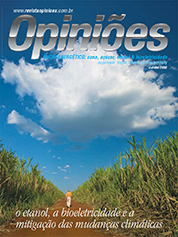Eduardo de Queiroz Monteiro
President of the EQM Group
Op-AA-22
Ethanol, Bioelectricity and the Climate
The world’s acknowledgement of environmental consequences, due to global warming, and their correlation with the consumption of fossil fuel, in Brazil finds one of the most consistent responses, brought about by the favorable factors it entails in contributing to the expansion of the supply of clean and renewable energy obtained from biomass, represented by the production of ethanol and the cogeneration of energy from sugarcane bagasse.
Thus, the belief is growing in international society that successful alternatives to fossil fuel must be sought and fostered at any cost. Brazil is the world’s best example of a large-scale program to reduce greenhouse gas emissions by replacing fossil fuel, due to ethanol’s extraordinary success as fuel, which is reflected in the growing fleet of “flex fuel” vehicles.
In 2009, practically 90% of the vehicles sold in the country were “flex fuel”, which shows the broad acceptance by the population of a system that allows the consumption of clean fuel, while enjoying an economic advantage. The Brazilian consumer has the power to decide which fuel to use every time he or she fills up the car.
To the extent that the population’s awareness level concerning the damaging effects on the environment of gas emissions increases, the higher the consumption level of clean energy will be, even under non-optimal economic conditions. Ethanol produced from sugarcane in Brazil is a “green” fuel, which, in itself, reduces emissions when compared with gasoline, but even in the very ethanol production process it sequesters a large quantity of carbon from the atmosphere, being capable of generating a positive biomass balance, which is to say that the process generates the energy necessary for transforming sugarcane into ethanol, while also allowing the use of excess biomass to produce electric power, the so-called bioelectricity.
The sugarcane volume currently produced in Brazil will allow us, in the near future, to generate an energy quantity higher than that generated in the country by the hydroelectric plants, to the extent that companies apply modern technologies in the production process and in cogeneration, which has actually been occurring in an upward trend in recent years.
We are faced with a new technological revolution, involving the production, in forthcoming years, of ethanol from pulp, which will open tremendous opportunities to grow the production of clean and renewable fuel, but will, once again, make sugarcane produced in Brazil extremely competitive in relation to other types of biomass. The first steps towards dismantling protectionist barriers against alcohol in the USA and the European Community were recently taken, and the trend is towards increased liberalization.
Such initiatives, by the way, are beneficial to Brazil, and possibly other alcohol producing and exporting countries, given that the diversification of sources tranquilizes buyers. Alcohol from sugarcane, with Brazil as the main attraction, is already the energy biomass option that has the highest productivity per area unit and the best life cycle (energy balance).
Life cycle is the ratio between the energy produced during the system’s total life and the energy consumed from its implementation to its decommissioning. While alcohol produced from corn in the USA has a cycle from between 1.2 and 1.4, in the case of sugarcane, it is above 8. No means of using solar energy, not even the photovoltaic one, has such a high life cycle. Despite this high productivity and life cycle, one may also expect significant improvement of these figures.
We hope that, in Copenhagen, we may see objective progress, in the sense that first world countries will take up a more effective and objective position in achieving the reduction targets for polluting gases and, finally, that we will take a significant step in the development of a mechanism that fosters the use of renewable and increasingly cleaner energy.
It is impossible to go on watching the progressive meltdown of polar layers and the climate effects we have been seeing in recent decades. We must be aware of the fact that any effort undertaken by any given human generation will only be noticed in the long-term. It is as if we were filling up our cars today, thinking of the well-being of future generations.





